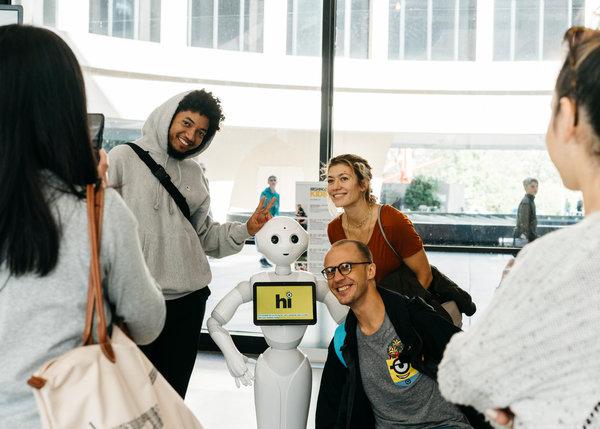This year, three Washington-based museums of the Smithsonian Institution deployed a half-dozen four-feet-tall, humanoid robots, nicknamed Pepper, to answer visitors’ questions and tell stories, using voice, gestures and an interactive touch screen. They also dance, play games and pose for selfies.
copyright by www.nytimes.com
 Rachel Goslins, director of the Smithsonian’s Arts and Industries Building and overseer of the robots’ deployment, said she has been “blown away” by visitors’ reactions to them.
Rachel Goslins, director of the Smithsonian’s Arts and Industries Building and overseer of the robots’ deployment, said she has been “blown away” by visitors’ reactions to them.
Pepper, she added, “feels totally aligned with the museums’ mission. We are asking people to be present, engaged, to have a communal experience. We’re not making you look at your phone even more; we’re creating a playful, joyful human experience.” She said 80 more robots eventually would be rolled out, helping to guide the work of the Smithsonian’s educators and docents.
(The museums using Pepper are the National Museum of African American History and Culture, the Hirshhorn Museum and Sculpture Garden, and National Museum of African Art, as well as the Smithsonian Castle, which is using eight robots, four of which can travel elsewhere.) The robot was created by SoftBank Robotics .
The Smithsonian venture into artificial intelligence to engage visitors is just one example in a rapidly moving trend mixing art and technology.
Artificial intelligence is increasingly being used today by museums of all sizes worldwide, which employ it to develop everything from robots, chatbots and websites, to tools that help them analyze visitor data and their collections, and determine admission policies and exhibition content.
The Akron Art Museum is encouraging visitors to use their phones to interact with Dot, its chatbot digital tour guide, which sports dark glasses and a pink pageboy. Introduced in August, Dot is accessible by the Facebook Messenger platform; when visitors enter the museum, they are directed to a kiosk that explains how Dot works.
Thank you for reading this post, don't forget to subscribe to our AI NAVIGATOR!
She takes visitors on a six-stop “choose your own adventure” tour of the museum’s permanent collection, discussing 60 works of art and asking visitors questions. In front of a Sol LeWitt mural in the museum’s lobby, for example, she explains that LeWitt did not personally paint the mural but that a drafter did. She calls this process delegating, and asks, “What part of your job do you wish you could assign to someone else?”[…]
read more – copyright by www.nytimes.com


This year, three Washington-based museums of the Smithsonian Institution deployed a half-dozen four-feet-tall, humanoid robots, nicknamed Pepper, to answer visitors’ questions and tell stories, using voice, gestures and an interactive touch screen. They also dance, play games and pose for selfies.
copyright by www.nytimes.com
Pepper, she added, “feels totally aligned with the museums’ mission. We are asking people to be present, engaged, to have a communal experience. We’re not making you look at your phone even more; we’re creating a playful, joyful human experience.” She said 80 more robots eventually would be rolled out, helping to guide the work of the Smithsonian’s educators and docents.
(The museums using Pepper are the National Museum of African American History and Culture, the Hirshhorn Museum and Sculpture Garden, and National Museum of African Art, as well as the Smithsonian Castle, which is using eight robots, four of which can travel elsewhere.) The robot was created by SoftBank Robotics .
The Smithsonian venture into artificial intelligence to engage visitors is just one example in a rapidly moving trend mixing art and technology.
Artificial intelligence is increasingly being used today by museums of all sizes worldwide, which employ it to develop everything from robots, chatbots and websites, to tools that help them analyze visitor data and their collections, and determine admission policies and exhibition content.
The Akron Art Museum is encouraging visitors to use their phones to interact with Dot, its chatbot digital tour guide, which sports dark glasses and a pink pageboy. Introduced in August, Dot is accessible by the Facebook Messenger platform; when visitors enter the museum, they are directed to a kiosk that explains how Dot works.
Thank you for reading this post, don't forget to subscribe to our AI NAVIGATOR!
She takes visitors on a six-stop “choose your own adventure” tour of the museum’s permanent collection, discussing 60 works of art and asking visitors questions. In front of a Sol LeWitt mural in the museum’s lobby, for example, she explains that LeWitt did not personally paint the mural but that a drafter did. She calls this process delegating, and asks, “What part of your job do you wish you could assign to someone else?”[…]
read more – copyright by www.nytimes.com
Share this: